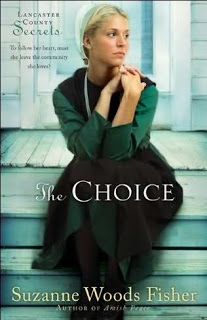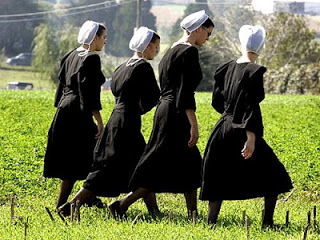1,635
 Hard to imagine, but with health care reform dominating the elections, there are pockets of Americans who choose not to have coverage, and instead rely on out-of-pocket costs: the Amish are one such group.
Hard to imagine, but with health care reform dominating the elections, there are pockets of Americans who choose not to have coverage, and instead rely on out-of-pocket costs: the Amish are one such group.And while a novel, the book The Choice (2010) by Suzanne Woods Fisher, depicts life with hemophilia in mostly accurate terms in the Amish community. The following was submitted by our wonderful PEN contributing writer, Richard Atwood, of North Carolina.
Carrie
Weaver, a blond-haired, blue-eyed Amish girl in Lancaster County, Pennsylvania, moves to Stoney Ridge at the age of 12 when her father, Jacob Weaver, who has hemophilia, remarries. Her mother died giving birth to Carrie’s younger brother, Andy. Over two years, Carrie has to suddenly grow up and make adult decisions that test her faith. Solomon Riehl, or Sol, who was born and raised Amish, receives a one-year contract to pitch baseball for the Lancaster Barnstormers. Sol asks Carrie to marry him outside the community. Sol enjoys his running-around years, the Rumspringa, that period before joining the Amish Plain folk with baptism,while being lured by the worldly “English” life. Carrie, who is attracted to Sol, is tempted to elope, despite objections by her father, until a horse unexpectedly kicks Jacob in the head. The Amish do not accept government assistance and do not buy health insurance. Esther, Jacob’s second wife, thinks infusions of factor IX cost too much so Jacob receives no treatment for this accident; he dies.
Weaver, a blond-haired, blue-eyed Amish girl in Lancaster County, Pennsylvania, moves to Stoney Ridge at the age of 12 when her father, Jacob Weaver, who has hemophilia, remarries. Her mother died giving birth to Carrie’s younger brother, Andy. Over two years, Carrie has to suddenly grow up and make adult decisions that test her faith. Solomon Riehl, or Sol, who was born and raised Amish, receives a one-year contract to pitch baseball for the Lancaster Barnstormers. Sol asks Carrie to marry him outside the community. Sol enjoys his running-around years, the Rumspringa, that period before joining the Amish Plain folk with baptism,while being lured by the worldly “English” life. Carrie, who is attracted to Sol, is tempted to elope, despite objections by her father, until a horse unexpectedly kicks Jacob in the head. The Amish do not accept government assistance and do not buy health insurance. Esther, Jacob’s second wife, thinks infusions of factor IX cost too much so Jacob receives no treatment for this accident; he dies.
Oddly, Carrie’s biological mother had been a frail carrier of hemophilia; Carrie’s brother also has hemophilia. Carrie quickly makes a life-altering choice; she chooses to care for her brother and to marry her father’s preferred suitor, Daniel Miller. Their marriage, held soon after in September, is one of convenience that is not consummated. Unfortunately, Daniel is killed in the following March when his horse and buggy are struck by
a teenage driver speeding in her car.
a teenage driver speeding in her car.
Now a young widow, Carrie assumes the responsibilities of a farm and a brother with hemophilia. Other household members include her older stepsister, Emma, who is looking for a husband, and Daniel’s cousin, Abel, who was recently released from prison in Ohio. To add to
Carrie’s problems, the deed to the farm is in Abel’s name and an unscrupulous land developer wants the Amish farms for a golf course. Carrie has never resolved her feelings for Sol and her choice of being Amish. Nine-year-old Andy is bullied by the English neighbors for having hemophilia. He is overly active, resulting in separate accidents of a broken arm and a cut heel requiring stitches and medical treatment. “Later, at the hospital, Carrie sat by Andy’s bedside in the emergency room as a long tube snaked from an IV bag into his vein, filling him with factor IX to help his blood clot. Mesmerized by the television hanging on the wall, Andy watched it, slack-jawed.” (p. 28).
Carrie’s problems, the deed to the farm is in Abel’s name and an unscrupulous land developer wants the Amish farms for a golf course. Carrie has never resolved her feelings for Sol and her choice of being Amish. Nine-year-old Andy is bullied by the English neighbors for having hemophilia. He is overly active, resulting in separate accidents of a broken arm and a cut heel requiring stitches and medical treatment. “Later, at the hospital, Carrie sat by Andy’s bedside in the emergency room as a long tube snaked from an IV bag into his vein, filling him with factor IX to help his blood clot. Mesmerized by the television hanging on the wall, Andy watched it, slack-jawed.” (p. 28).
Richard writes, “This romance novel illuminates the struggles of the Pennsilfaanisch Deitsch (Pennsylvania Dutch) to maintain their Plain folk lifestyle while coping with intrusions by the “English.” The characters usually speak English though they occasionally interject the Deitsch vernacular, followed by an English translation in italics to assist the reader. The rare case of a person with hemophilia marrying a carrier of hemophilia is accurately described and is possible due to the marriage patterns in this closed community. Other than the unexplained treatment in the hospital of using intravenous bags rather than syringes for factor IX infusions, the portrayal of having hemophilia is realistic, with treatment covered only by personal payment. The author, whose grandfather was raised Amish in Franklin County, Pennsylvania, lives with her family in San Francisco, California.”
We’re fortunate in that some HTCs, such as the Indiana Hemophilia and Thrombosis Center, care for the Amish, and don’t use bags of plasma! The Amish are a true community: when there are extreme medical costs, the community rallies together to pay for the treatment without relying on hand-outs from the government. Difficult but highly admirable. A good read, which Richard recommends.
Suzanne Woods Fisher, 2010, The Choice. Grand Rapids, MI: Revell. 309 pages.


